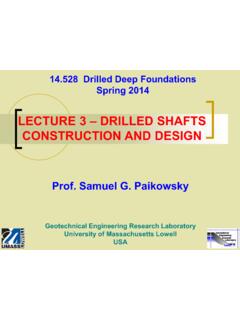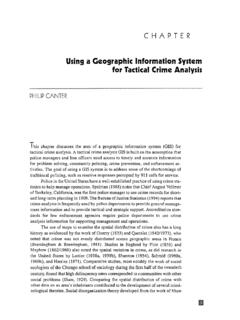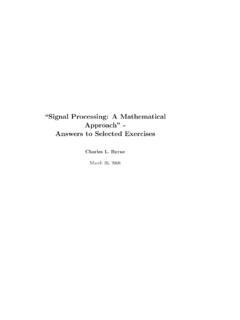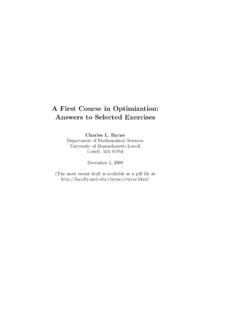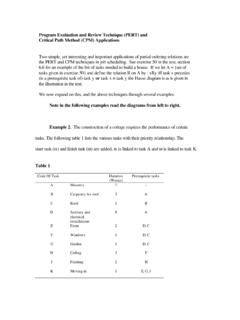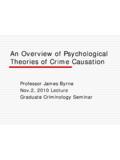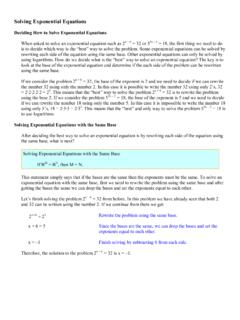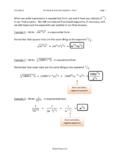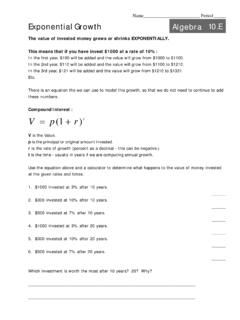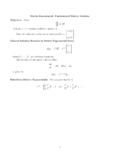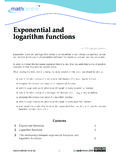Transcription of The Matrix Exponential - Faculty Server Contact | UMass Lowell
1 The Matrix Exponential (with exercises)by Dan and comments are Matrix ExponentialFor eachn ncomplex matrixA, define theexponentialofAto be the Matrix (1)eA= k=0 Akk!=I+A+12!A2+13!A3+ It is not difficult to show that this sum converges for all complex matricesAof any finitedimension. But we will not prove this a 1 1 Matrix [t], theneA= [et], by the Maclaurin series formula for the functiony=et. More generally, ifDis a diagonal Matrix having diagonal entriesd1,d2, .. ,dn,then we haveeD=I+D+12!D2+ = 10 001.
2 00 0 1 + d10 00d2 ..00 0dn + d212!0 00d212! ..00 0d212! + = ed10 00ed2 ..00 0edn The situation is more complicated for matrices that are not diagonal. However, if amatrixAhappens to bediagonalizable, there is a simple algorithm for computingeA, aconsequence of the following A and P be complex n n matrices, and suppose that P is invertible. TheneP 1AP=P that, for all integersm 0, we have(P 1AP)m=P 1 AmP. The definition (1)then yieldseP 1AP=I+P 1AP+(P 1AP)22!
3 + =I+P 1AP+P 1A22!P+ =P 1(I+A+A22!+ )P=P 1eAP If a matrixAis diagonalizable, then there exists an invertiblePso thatA=PDP 1,whereDis a diagonal Matrix of eigenvalues ofA, andPis a Matrix having eigenvectorsofAas its columns. In this case,eA=PeDP :LetAdenote the matrixA=[5 1 2 2]The reader can easily verify that 4 and 3 are eigenvalues ofA, with corresponding eigen-vectorsw1=[1 1]andw2=[1 2]. It follows thatA=PDP 1=[11 1 2][4 00 3][21 1 1]so thateA=[11 1 2][e400e3][21 1 1]=[2e4 e3e4 e32e3 2e42e3 e4] The definition (1) immediately reveals many other familiar properties.
4 The followingproposition is easy to prove from the definition (1) and is left as an A be a complex square n n Matrix .(1)If0denotes the zero Matrix , then e0=I, the identity Matrix .(2)AmeA=eAAmfor all integers m.(3)(eA)T=e(AT)(4)If AB=BA then AeB=eBA and eAeB= not all familiar properties of the scalar Exponential functiony=etcarryover to the Matrix Exponential . For example, we know from calculus thates+t=esetwhensandtare numbers. However this is oftennot truefor exponentials of other words, it is possible to haven nmatricesAandBsuch thateA+B6= , for example, Exercise10at the end of this section.
5 Exactly when we have equality,eA+B=eAeB, depends on specific properties of the matricesAandBthat will be exploredlater on. Meanwhile, we can at least verify the following limited A be a complex square Matrix , and let s,t C. TheneA(s+t)= the definition (1) we haveeAseAt=(I+As+A2s22!+ )(I+At+A2t22!+ )=( j=0 Ajsjj!)( k=0 Aktkk!)= j=0 k=0Aj+ksjtkj!k!( )3 Letn=j+k, so thatk=n j. It now follows from( )thateAseAt= j=0 n=jAnsjtn jj!(n j)!= n=0 Ann!n j=0n!j!(n j)!sjtn j= n=0An(s+t)nn!=eA(s+t) Settings=1 andt= 1 in Proposition3, we find thateAe A=eA(1+( 1))=e0= other words, regardless of the matrixA, the Exponential matrixeAisalwaysinvertible,and has inversee can now prove a fundamental theorem about Matrix exponentials.
6 Both the statementof this theorem and the method of its proof will be important for the study of differentialequations in the next A be a complex square Matrix , and let t be a real scalar variable. Let f(t) = f (t) = Proposition3to the limit definition of derivative yieldsf (t) =limh 0eA(t+h) eAth=eAt(limh 0eAh Ih)Applying the definition (1) toeAh Ithen gives usf (t) =eAt(limh 01h[Ah+A2h22!+ ])=eAtA=AeAt. Theorem4is the fundamental tool for proving important facts about the Matrix exponen-tial and its uses.
7 Recall, for example, that there existn nmatricesAandBsuch thateAeB6=eA+B. The following theorem provides a condition for when this identity A,B be n n complex matrices. If AB=BA then eA+B= , it follows from the formula (1) thatAeBt=eBtA, and similarly forother combinations ofA,B,A+B, and their (t) =e(A+B)te Bte At, wheretis a real (scalar) variable. By Theorem4, and theproduct rule for derivatives,g (t) = (A+B)e(A+B)te Bte At+e(A+B)t( B)e Bte At+e(A+B)te Bt( A)e At= (A+B)g(t) Bg(t) Ag(t)= then nzero Matrix .
8 Note that it was only possible to factor( A)and( B)out of the terms above because we areassumingthatAB= (t) =0for allt, it follows thatg(t)is ann nmatrix ofconstants, sog(t) =Cforsome constant matrixC. In particular, settingt=0, we haveC=g(0). But the definitionofg(t)then givesC=g(0) =e(A+B)0e B0e A0=e0e0e0=I,4the identity Matrix . Hence,I=C=g(t) =e(A+B)te Bte Atfor allt. After multiplying byeAteBton both sides we haveeAteBt=e(A+B)t. , the zero Matrix , prove thateA=I+ the definition (1) of the Matrix Exponential to prove the basic properties listed inProposition2.
9 (Do not use any of the theorems of the section! Your proofs should useonly the definition (1) and elementary Matrix algebra.) thatecI+A=eceA, for all numberscand all square thatAis a realn nmatrix and thatAT= A. Prove thateAis an orthogonalmatrix ( Prove that, ifB=eA, thenBTB=I.) find a nice simple formula foreA, similar to the formula in the firstexercise each of the following examples:(a)A=[0 10 0](b)A=[1 10 1](c)A=[a b0a] each of the following examples:(a)A=[a b0 0](b)A=[a0b0] , show that2eA=(e+1e)I+(e 1e) CandX Cnis a non-zero vector such thatAX= thateAX=e the matricesA=[1 00 0]B=[0 10 0]Show by direct computation thateA+B6= a squaren nmatrixAis defined to be the sum of its diagonal entries.
10 Trace(A)=a11+a22+ + that, ifAis diagonalizable, then det(eA) =etrace(A).Note:Later it will be seen that this is true for all square Answers and (eA)T=eAT, whenAT= Awe have(eA)TeA=eATeA=e AeA=eA A=e0= + (e 1) (a)eA=[1 10 1](b)eA=[e e0e](c)A=[eaeab0ea]7.(a)eA=[eaba(ea 1)01](b)eA=[ea0ba(ea 1)1](Replaceba(ea 1)by1in each case ifa=0.)6 Linear Systems of Ordinary Differential EquationsSuppose thaty=f(x)is a differentiable function of a real (scalar) variablex, and thaty =ky, wherekis a (scalar) constant.
